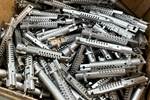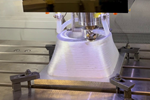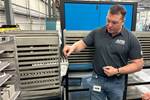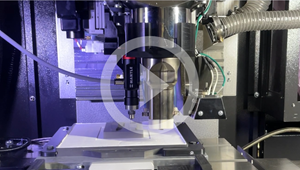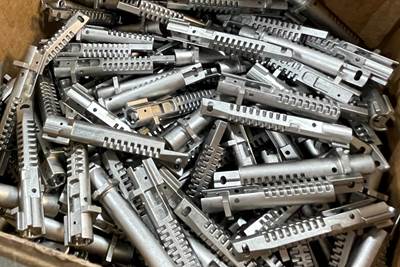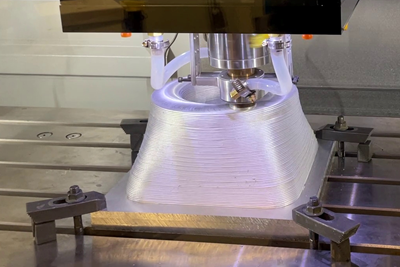Alpha Precision Group (APG) in Ridgway, Pennsylvania, has a history of manufacturing parts through powder metallurgy. Along with conventional techniques including press and sinter and metal injection molding (MIM), the company also uses a collection of metal 3D printing techniques including binder jetting, bound metal deposition (BMD) and now MoldJet to manufacture metal parts.
The MoldJet process developed by Tritone Technologies combines powder metallurgy with 3D printed wax molds used to form the green parts layer by layer. This video explores how this sinter-based additive manufacturing process works, and some of the use cases that APG is finding for this technology.
Transcript
I’m Stephanie Hendrixson with Additive Manufacturing Media. I'm learning about sinter-based additive manufacturing here at Alpha Precision Group, APG, in Ridgway, Pennsylvania.
This is a MIM company, a metal injection molding company that has adopted various types of metal 3D printing, including bound metal deposition, binder jetting, and this most recent addition. This is a MoldJet printer, the Dominant platform from Tritone Technologies.
This machine uses a carousel system with multiple different stations to accomplish higher volume 3D printing of green metal parts.
It starts with a wax build platform that is first leveled. Once it's flat, the build platform goes to the print station where four different printheads are precisely dropping wax to basically build up a stencil, a mold for the ultimate metal part. The stencil is built up in layers that are 130 microns high, and then they are machined down to be exactly 100 microns.
Then there is a slurry, a paste of metal powder with some additives that is flowed into the mold to start building up the structure of the parts.
From there, the build platform travels to one of two drying stations. There are two inside the machine so that you can be running up to six different build platforms at once without wasting any time. And then each layer is inspected before the whole process starts again.
Once the build is complete, the entire build platform goes into an oven where the wax is melted away. And then finally the brown metal parts go through a sintering furnace to achieve their final part properties.
The Tritone process results in isotropic shrinkage, so it's predictable and parts shrink evenly from all dimensions.
APG is finding this machine and this technology useful for a couple of different applications. They're doing a lot of things to bridge customers from 3D printing into MIM. So this is a way to test out geometries and to experiment with sintering conditions before cutting the tool and going to metal injection molding.
But it also makes sense for certain end use components as well, especially those with complicated geometries that would be difficult to mold or difficult to make with binder jetting and those with complicated internal features where it would be too challenging to remove the powder from inside.
Some of the end use parts that they're making with this system include components for firearms, other industrial applications and situations where quantities are maybe in the hundreds to the thousands, where it doesn't make economic sense to go to metal injection molding.
Related Content
AM 101: What Is Binder Jetting? (Includes Video)
Binder jetting requires no support structures, is accurate and repeatable, and is said to eliminate dimensional distortion problems common in some high-heat 3D technologies. Here is a look at how binder jetting works and its benefits for additive manufacturing.
Read MorePostprocessing Steps and Costs for Metal 3D Printing
When your metal part is done 3D printing, you just pull it out of the machine and start using it, right? Not exactly.
Read More3D Printing Molds With Metal Paste: The Mantle Process Explained (Video)
Metal paste is the starting point for a process using 3D printing, CNC shaping and sintering to deliver precise H13 or P20 steel tooling for plastics injection molding. Peter Zelinski talks through the steps of the process in this video filmed with Mantle equipment.
Read MoreAM 101: What Is Hot Isostatic Pressing (HIP)? (Includes Video)
Hot isostatic pressing has long been used for metal castings, but is now being applied as a valuable method for closing porosity in metal 3D printed parts.
Read MoreRead Next
Binder Jetting Follows in Footsteps of Metal Injection Molding
For Smith Metal Products, additive manufacturing helps MIM customers finalize the design, but production opportunities are waiting.
Read MoreUnusual Forms of 3D Printing, and How to Categorize This Technology: AM Radio #21A
In this episode of AM Radio, Stephanie Hendrixson and Peter Zelinski quiz each other on six 3D printing processes — some common, some novel. Test your own knowledge and stick around for a discussion about how to categorize (or maybe re-categorize) AM technologies.
Read MoreSinter-Based Additive Manufacturing Finds a Place Alongside MIM, Press and Sinter at APG
Powder metallurgy company Alpha Precision Group (APG) is applying a particular class of metal 3D printing technology for both rapid iteration in development and flexibility in production.
Read More

.jpg;width=70;height=70;mode=crop)
